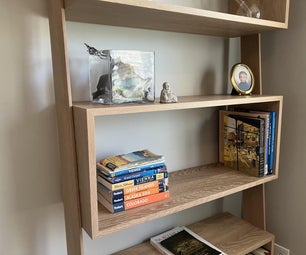Introduction: Circular Cardboard Shadowbox (Hot-glue Method)
This mini cardboard shadowbox is a template for a much larger Circular Bookshelf.
Its durable and great for holding your most memorable and treasured miniature items.
When I'm able to find more cardboard, I'll put up images of the larger bookshelf, using these instructions.
In the meanwhile, enjoy the mini version!
It was based on an educated guess of how it MIGHT be constructed with -
lots of glue and a bit of planning. It took a couple hours only to glue. Then took just two days
to waterproof with DIY ingredients and decorate.
The shape was greatly influenced by Elsa Paige bookshelf designs.
The construction concepts were learnt from Eric Guiomar.
Instead of using frets like Eric Guiomar likes to use,
I used polyurethane glue and external frets to give strong support to each shelf.
For visual learners, here is the speedy rundown of this instructable on video below.
Its durable and great for holding your most memorable and treasured miniature items.
When I'm able to find more cardboard, I'll put up images of the larger bookshelf, using these instructions.
In the meanwhile, enjoy the mini version!
It was based on an educated guess of how it MIGHT be constructed with -
lots of glue and a bit of planning. It took a couple hours only to glue. Then took just two days
to waterproof with DIY ingredients and decorate.
The shape was greatly influenced by Elsa Paige bookshelf designs.
The construction concepts were learnt from Eric Guiomar.
Instead of using frets like Eric Guiomar likes to use,
I used polyurethane glue and external frets to give strong support to each shelf.
For visual learners, here is the speedy rundown of this instructable on video below.
Step 1: What You Will Need
A small cardboard box
Gummed watercolour tape
Metal ruler
Sharp cutter
Strong glue
Paintbrush
File
Trace a circular object the preferred size of your shadowbox. Cut with sharp knife.
Draw with marker where you wish to glue the shelves.
Gummed watercolour tape
Metal ruler
Sharp cutter
Strong glue
Paintbrush
File
Trace a circular object the preferred size of your shadowbox. Cut with sharp knife.
Draw with marker where you wish to glue the shelves.
Step 2: Bend Cardboard to Curves
Cut rectangular pieces.
The height of each piece will determine the depth of your box.
Bend over a tube shape or edge of a table to create a neat curve.
The height of each piece will determine the depth of your box.
Bend over a tube shape or edge of a table to create a neat curve.
Step 3: Attaching Shelf Layer
Use either hot glue or polyurethane glue, which will dry quickly under pressure, to join the rectangular pieces to the circular backing.
Use gummed tape to cover holey edges.
Step 4: Decorating - Waterproofing
This step is really important to create a waterproof product.
There are three layers - PVA, joint compound and paint.
1. The first layer is a 1:1 mix of pva glue and water. Cover the entire surface of your shadowbox, including the open holes. Leave to dry overnight.
There are three layers - PVA, joint compound and paint.
1. The first layer is a 1:1 mix of pva glue and water. Cover the entire surface of your shadowbox, including the open holes. Leave to dry overnight.
Step 5: Decorating - Waterproofing 2
2. Next cover the shadowbox with joint compound or crack filla. I made my own using PVA glue, water and bit of cement mix (calcium carbonate). I blended it to a smooth mix.
The ratio was 1:1:1. Dry overnight
The next day it dried to a solid, rock solid surface.
File and sand down. I only filed the edges and left the rest quite lumpy and bumpy for a rustic look.
The ratio was 1:1:1. Dry overnight
The next day it dried to a solid, rock solid surface.
File and sand down. I only filed the edges and left the rest quite lumpy and bumpy for a rustic look.
Step 6: Decorating - Add Colour 3
The cardboard surface is now ready for painting.
I used acrylic paint and will paint another layer then file down again soon.
The next day I chose a light cerise blue to cover the darker green layer.
I mixed pva glue, water and acrylic paints.
It looks a lot cheerful now I think.
I used acrylic paint and will paint another layer then file down again soon.
The next day I chose a light cerise blue to cover the darker green layer.
I mixed pva glue, water and acrylic paints.
It looks a lot cheerful now I think.











